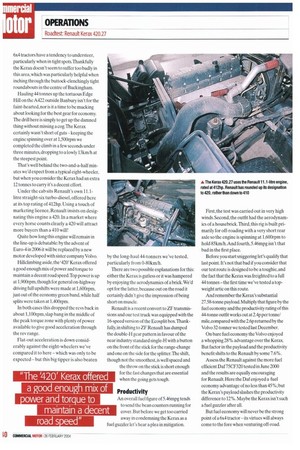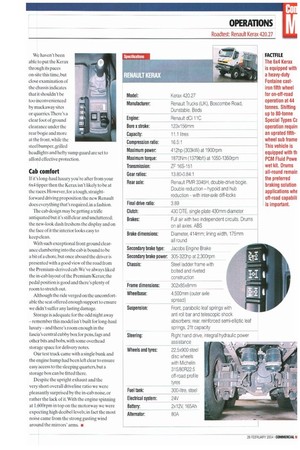F 'I' F O R 1: 0 111IP O SE
Page 38

Page 40

Page 41

If you've noticed an error in this article please click here to report it so we can fix it.
Fuel efficiency is never going to be a 6x4 tractor's strongpoint, but there's more to tipper work than how much you put in the tank — and the Kerax is a grafter.
This week's roadtest contender is the Renault Kerax 6x4 tractor, a no-nonsense.heavy-duty tractor aimed at the uncompromising muckaway and heavy-haulage sectors.This is a rugged machine, punted squarely at a niche market dominated by the likes of Foden and Mercedes. If the Kerax is going to snatch a slice of this cake it will need to put in a high-class performance.
As regular readers know, tractive units are usually tested round our Scottish test route. However,6x4 tractors are not best suited to this route and they're not often to be seen tramping up and down the UK on long-haul work. Instead, we opted to take the Kerax, coupled to a short tipping trailer. around our Midlands tipper route where the new Renault could be evaluated more effectively.
On the road Take a look at the Kerax and its mission is immediately apparent.The straight-beam front axle means a high-mounted cab and plenty of ground clearance — 378mm to be precise — while the double-reduction back end ensures the gearing is right for heavyweight applications. Robust 300rnm chassis rails give the Kerax the beefy appearance you'd expect for this sort of application.
Riding on hefty steel suspension front and rear we were never expecting pothole-flattening ride comfort from the Kerax double-drive workhorse. But while we were ready for a hard ride we didn't expect it to be quite so bumpy — the constant bobbing of the cab got a bit tiring after a few hours in the saddle. 'Twas ever thus with steel suspended double-drive bogies, particularly with a tipping trailer set so far back over the kingpin, although we've driven more comfortable 6x4 tractors recently While ride comfort may not be one of the Kerax's strong points it scores highly in a number of other areas.not least road handling where it sticks to the road and gives a very assured drive.The steering setup is nicely weighted and the handy sized Renault steering wheel makes for easy manoeuvring. In general, 6x4 tractors have a tendency to understeer, particularly when in tight spots.Thankfully the Kerax doesn't seem to suffer too badly in this area, which was particularly helpful when inching through the buttock-clenchingly tight roundabouts in the centre of Buckingham.
Hauling 44 tonnes up the tortuous Edge Hill on the A422 outside Banbury isn't for the faint-hearted.nor is it a time to be mucking about looking for the best gear for economy. The drill here is simply to get up the damned thing without missing a cog.The Kerax certainly wasn't short of guts keeping the engine spinning over at 1,500rpm we completed the climb in a few seconds under three minutes, dropping to a lowly 13km/h at the steepest point.
That's well behind the two-and-a-half minutes we'd expect from a typical eight-wheeler, but when you consider the Kerax had an extra 12 tonnes to carry it's a decent effort.
Under the cab sits Renault's own 11.1litre straight-six turbo-diesel, offered here at its top rating of 412hp. Using a touch of marketing licence, Renault insists on designating this engine a 420. In a market where every horse counts clearly a 420 will attract more buyers than a 410 will!
Quite how long this engine will remain in the line-up is debatable: by the advent of Euro-4in 2006 it will be replaced by a new motor developed with sister company Volvo.
Hillclimbing aside, the '420' Kerax offered a good enough mix of power and torque to maintain a decent road speed.Top power is up at 1.900rpm, though for general on-highway driving full upshifts were made at 1.600rpm. just out of the economy green band,while half splits were taken at 1,400rpm.
In both cases this dropped the revs back in about 1,100rprn, slap bang in the middle of the peak torque zone with plenty of power available to give good acceleration through the rev range.
Flat-out acceleration is down considerably against the eight-wheelers we've compared it to here which was only to be expected but this big tipper is also beaten by the long-haul 44-tonners we've tested, particularly from 0-80km/h.
There are two possible explanations for this: either the Kerax is gutless or it was hampered by enjoying the aerodynamics of a brick.We'd opt for the latter. because out on the road it certainly didn't give the impression of being short on muscle.
Renault is a recent convert to ZF transmissions and our test truck was equipped with the 16-speed version of the Ecosplit box.Thankfully, in shifting to ZF Renault has dumped the double-H gear pattern in favour of the near industry standard single-H with a button on the front of the stick for the range-change and one on the side for the splitter. The shift, though not the smoothest, is well spaced and the throw on the stick is short enough for the fast changes that are essential when the going gets tough.
Productivity
An overall fuel figure of 5.46mpg tends to send the bean counters running for cover. But before we get too carried away in condemning the Kerax as a fuel guzzler let's hear a plea in mitigation. First, the test was carried out in very high winds. Second, the outfit had the aerodynamics of a housebrick.Third, this rig is built primarily for off-roading with a very short rear axle so the engine is spinning at 1,600rpm to hold 85km/h.And fourth.5.46mpg isn't that bad in the first place.
Before you start sniggering let's qualify that last point. It's not that bad if you consider that our test route is designed to be a toughie, and the fact that the Kerax was freighted to a full 44 tonnes -the first time we've tested atopweight artic on this route.
And remember the Kerax's substantial 27.58-tonne payload. Multiply that figure by the fuel economy and the productivity rating of this 44-tonne outfit works out at 2.4p per tonne/ mile, compared with the 2.6p returned by the Volvo 32-tonner we tested last December.
On bare fuel economy the Volvo enjoyed a whopping 28% advantage over the Kerax. But factor in the payload and the productivity benefit shifts to the Renault by some 7.6%.
Assess the Renault against the more fuel efficient Daf 75CF320 tested in June 2000 and the results are equally encouraging for Renault. Here the Daf enjoyed a fuel economy advantage of no less than 45%; but the Kerax's payload slashes the productivity difference to 12%. Maybe the Kerax isn't such a fuel guzzler after all.
But fuel economy will never be the strong point of a 6x4 tractor -its virtues will always come to the fore when venturing off-road. We haven't been able to put the Kerax through its paces on-site this time, but close examination of the chassis indicates that it shouldn't be too inconvenienced by muckaway sites or quarries. There's a clear foot of ground clearance under the rear bogie and more at the front, while the steel bumper, grilled headlights and hefty sump guard are set to afford effective protection.
Cab comfort If it's long-haul luxury you're after from your 6x4 tipper then the Kerax isn't likely to be at the races. However, for a tough, straightforward driving proposition the new Renault does everything that's required, in a fashion.
The cab design may be getting a trifle antiquated but it's still clear and uncluttered; the new-look dash freshens the display and on the face of it the interior looks easy to keep clean.
With such exceptional front ground clearance clambering into the cab is bound to be a bit of a chore, but once aboard the driver is presented with a good view of the road from the Premium-derived cab. We've always liked the in-cab layout of the Premiumaerax;the pedal position is good and there's plenty of room to stretch out.
Although the ride verged on the uncomfortable the seat offered enough support to ensure we didn't suffer any lasting damage.
Storage is adequate for the odd night away —remember this model isn't built for long-haul luxury —and there's room enough in the fascia's central cubby box for pens, fags and other bits and bobs, with some overhead storage space for delivery notes.
Our test truck came with a single bunk and the engine hump had been left clear to ensure easy access to the sleeping quarters,but a storage box can be fitted there.
Despite the upright exhaust and the very short overall driveline ratio we were pleasantly surprised by the in-cab noise, or rather the lack of it. With the engine spinning at 1,600rpm in top on the motorway we were expecting high decibel levels; in fact the most noise came from the strong gusting wind around the mirrors' arms. •






























































































































































































